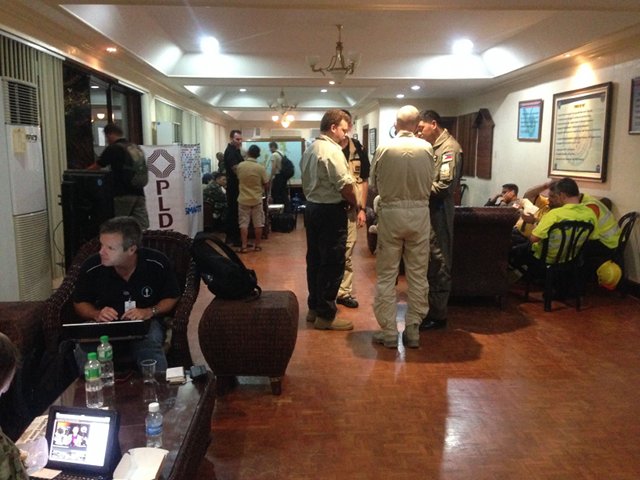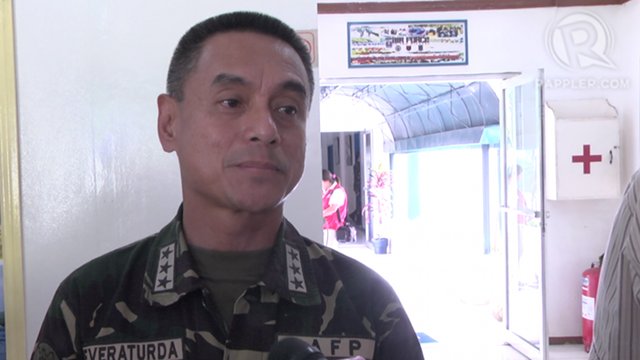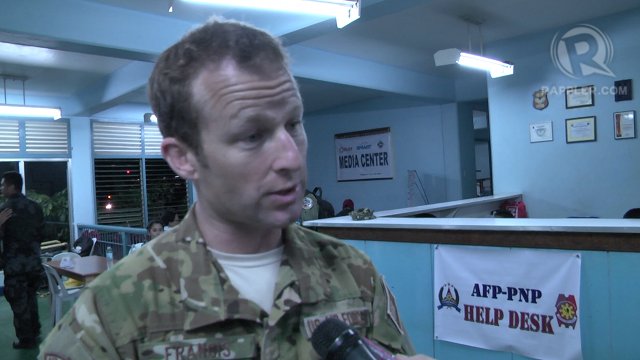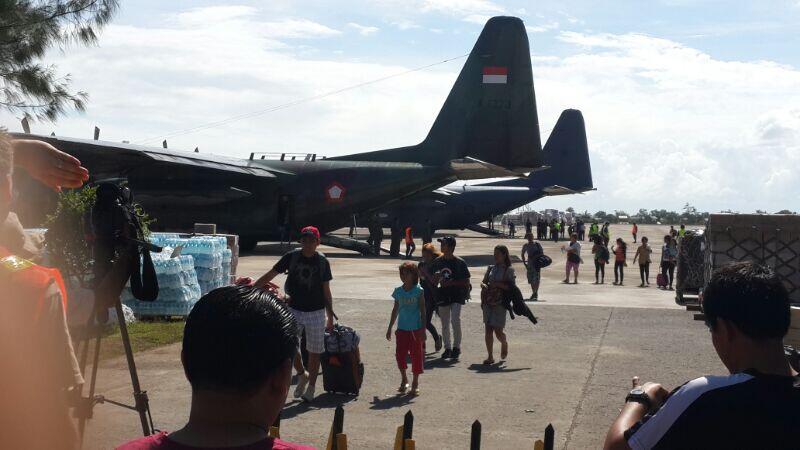On the most massive and complex relief operations
the Philippines ever had!
By Ayee Macaraig and Ana Marie Pamintuan
25 November 2013


They also divide the work according to time.
Francis said, “There are some US air force controllers that are assisting the Philippine air traffic control in the day and in the night time, the US forces control the fields to enable 24 hours delivery of supplies.”
Catching up with aid delivery
Lt Jim Alagao, spokesperson of the AFP Central Command, said that 9 days after the typhoon, the relief effort is still in the early stage, focused on feeding the victims.
Alagao said though that there has been improvement in the delivery of aid.
“I talked to some foreign reporters who went to Guiuan on Friday and their observation was there were no trucks, only motorcycles. When they came back Saturday, they were surprised there were 30 to 40. That came from Manila and the reinforcement trucks. We hope to bring the goods from Guiuan to the suburbs.”
Francis said the priorities in the coming days will be to shift from providing the basic needs to infrastructure like water purification systems and tent cities. The US is also setting up refueling points for its helicopters so they do not have to go back to the ships or the base.
Indonesian Ambassador Kristiarto Legowo said his country brought in a C130 on Saturday and the Indonesian contingent will stay until November 24 to support the humanitarian operations, upon the request of the AFP. A new Japanese medical team also flew to Tacloban on Saturday.
The European Union’s Altheim said the EU is pledging 30 million euros to the recovery efforts.
The international team though acknowledged criticism about the pace of relief efforts.
“I know it’s a little bit slow and I’m sure it’s very frustrating for the people on the ground but I think the coalition is really starting to catch up with the aid,” Francis said.
For Australian representative Jonathan Gilbert, assessing the work involves taking into account the realities on the ground and the scale of the devastation.
the Philippines ever had!
By Ayee Macaraig and Ana Marie Pamintuan
25 November 2013
The base operations at the Benito Ebuen Air Base in Mactan for relief efforts for Super Typhoon Yolanda (Haiyan) is a virtual United Nations.
On the tarmac, an Australian Air Force plane takes off while an Emirates aircraft lands. Outside the gate, an American soldier counts the heads of the responders and Filipino relatives boarding a flight to Tacloban. In the VIP room, ambassadors get updates on the relief work. Right outside, Japanese medics huddle while Spanish relief workers conduct their own informal briefing.
English in various accents fill the command center, as air force troops from several countries fly in and out of the hub for the airborne rescue and relief operations in the Visayas. The languages are different, the groups countless. Yet there is only one goal: to get the people and cargo moving so the victims of the world’s strongest typhoon have much-needed food, water, shelter and medical care.
On the tarmac, an Australian Air Force plane takes off while an Emirates aircraft lands. Outside the gate, an American soldier counts the heads of the responders and Filipino relatives boarding a flight to Tacloban. In the VIP room, ambassadors get updates on the relief work. Right outside, Japanese medics huddle while Spanish relief workers conduct their own informal briefing.
English in various accents fill the command center, as air force troops from several countries fly in and out of the hub for the airborne rescue and relief operations in the Visayas. The languages are different, the groups countless. Yet there is only one goal: to get the people and cargo moving so the victims of the world’s strongest typhoon have much-needed food, water, shelter and medical care.

Despite the large number of troops under various national commands, however, the operations are generally smooth, with the PAF coordinating the missions and running the center like a commercial airport.
The Philippine Air force (PAF) said that with the large number of aircraft, the tarmac, which the air base shares with the Mactan-Cebu International Airport, would be clogged with planes and relief goods and crippled within two days. Mactan Airbase can handle only three aircraft on the ground at one time.
The Philippine Air force (PAF) said that with the large number of aircraft, the tarmac, which the air base shares with the Mactan-Cebu International Airport, would be clogged with planes and relief goods and crippled within two days. Mactan Airbase can handle only three aircraft on the ground at one time.
So the PAF devised a system of facilitating air traffic at the command center, with computerized flight information displayed on a computer screen at the reception area and regularly updated, like in commercial airports.
The Philippine military directs the delivery of aid, with Lt Gen Roy
Deveraturda, chief of the central command of the Armed Forces of the
Philippines (AFP) leading what soldiers often refer to as the
“coalition” effort.
He controls deployment of 12 C-130's from different nations, including three of his very own.

Philippine-led ‘coalition’
“There’s a lot of pieces in the puzzle. Overall you have Manila but in
terms of this operations center, in terms of flights, where we should
take our military assets, we run to him and say, ‘What’s the need today?
What flight times can we get?’ And then he goes from there,” said
Jonathan Gilbert of the Australian Embassy in Manila who has been in the
base for 5 days now.
Several countries have brought tons of relief goods to Cebu on their own military C-130 Hercules transport planes, which can operate efficiently even in a harsh environment. A few, like Australia, Indonesia, Japan, New Zealand, Singapore, Sweden, South Korea, and the United States, allow their aircraft to be used to transport relief goods donated by others or prepared by the Philippine government, and to bring evacuees to Cebu from devastated villages in Samar and Leyte.
From 5 a.m. till early evening, there is an unending stream of mostly C-130s flying out of or into the air base. The Americans have also deployed helicopters and the V-22 Osprey, a fixed wing aircraft capable of vertical takeoff and landing like a helicopter, but they don’t take up space in Mactan.
From 5 a.m. till early evening, there is an unending stream of mostly C-130s flying out of or into the air base. The Americans have also deployed helicopters and the V-22 Osprey, a fixed wing aircraft capable of vertical takeoff and landing like a helicopter, but they don’t take up space in Mactan.
Instead the US Ospreys mostly fly in and out of the devastated islands from Clark Airbase in Pampanga, and the MH-60S Seahawk helicopters then return to their aircraft carrier, George Washington anchored east of Samar.
To coordinate air traffic, the command center was opened on Monday last week and was up and running by Wednesday. All arriving foreign air force teams must check in at the command center, then fill out forms declaring their personnel composition, the goods and equipment being brought in, the needs of the team, and the identities and contact numbers of the flight leader and load master.
All planned flights must be proposed for approval to the command center by 1:30 p.m. the day before. A coordination meeting attended by representatives of each “partner nation” and the PAF is held at 3 p.m.
To coordinate air traffic, the command center was opened on Monday last week and was up and running by Wednesday. All arriving foreign air force teams must check in at the command center, then fill out forms declaring their personnel composition, the goods and equipment being brought in, the needs of the team, and the identities and contact numbers of the flight leader and load master.
All planned flights must be proposed for approval to the command center by 1:30 p.m. the day before. A coordination meeting attended by representatives of each “partner nation” and the PAF is held at 3 p.m.
Handling of aircraft begins two hours before departure. PAF ground maintenance crew, many still in training, assist in the cargo handling, which is swift and orderly.
Essential goods and equipment as well as essential personnel are given priority in departure. Aircraft with no night vision capability get priority for daytime flights.
Essential goods and equipment as well as essential personnel are given priority in departure. Aircraft with no night vision capability get priority for daytime flights.
Geographic Division of Work
The foreign countries military contingent also divide the work geographically.
Major Jimmy Francis
of the US Air Force said the United States focused on the east coast of
Samar including Guiuan, while the Australians and New Zealand moved toward
Roxas City to the west to join Canada, while their Israeli counterpart set up shop in Bogo, Cebu.
“The USS George Washington is there with a fleet of SH-60 helicopters and they’re covering the east coast. Also, the US Marine Corps was bringing in supplies to Guiuan. I don’t think they’re quite going to Borongan yet but in the future, in the next couple of days, they’re gonna start doing that, also Ormoc and of course, Tacloban,” Francis said.
“The USS George Washington is there with a fleet of SH-60 helicopters and they’re covering the east coast. Also, the US Marine Corps was bringing in supplies to Guiuan. I don’t think they’re quite going to Borongan yet but in the future, in the next couple of days, they’re gonna start doing that, also Ormoc and of course, Tacloban,” Francis said.
Guiuan airport was basically crowded with US Air Force Ospreys and Black Hawk
helicopters. But other aircraft landed their as well. The New Zealand C-130 delivered relief goods Wednesday and waited on the runway for about 15
minutes as the Americans moved their Ospreys away from the unloading
area.
With a forklift and help from locals, it took less than an hour for the Kiwis to unload the relief goods and take in several evacuees. It was pitch-black as the C-130 took off at around 6:30 p.m.
About 45 minutes later, it was back in Mactan, taking its place among about 12 other Hercules planes parked for the night, their teams resting for the next day’s work.
With a forklift and help from locals, it took less than an hour for the Kiwis to unload the relief goods and take in several evacuees. It was pitch-black as the C-130 took off at around 6:30 p.m.
About 45 minutes later, it was back in Mactan, taking its place among about 12 other Hercules planes parked for the night, their teams resting for the next day’s work.
They also divide the work according to time.
Francis said, “There are some US air force controllers that are assisting the Philippine air traffic control in the day and in the night time, the US forces control the fields to enable 24 hours delivery of supplies.”
Problem of airfields, land transport
Officials admit logistics is a key challenge, particularly how to transport aid.
“It’s on a certain level of Haiti or the tsunami and so we are working on that level of this large-scale humanitarian operations and of this large amount of needs of the population,” said Christoph Altheim, coordination and assessment expert from the European Civil Protection Mechanism.
Gilbert said the whole group is using a lot of equipment to address the problem.
“It entails everything from big things like planes to things you wouldn’t necessarily think about like forklifts, trolleys to move supplies. I think the biggest challenge for logistics is airfields in some regard. We can only bring heavy planes into certain areas. We can’t fly heavy planes into small villages. That’s where the arrival of the US aircraft carrier really helps.”
Francis said the US strategy is to bring in supplies to the large bases first through ships or huge aircraft like the C17 then use “more tactical level aircraft” like the C130s, MV-22 Ospreys and Navy SH-60 helicopters then forward these to the airfields. Smaller helicopters will then deliver relief goods to barangays.
Having worked in recovery in the 2010 Haiti quake, Hurricane Katrina in 2005 and other US military missions abroad, Francis said Haiyan is one of the most complex operations he has been a part of.
“The breadth of destruction is pretty wide. Transportation is very difficult on the ground. There are many barangays that are unreachable. There are a lot of aviation assets so I think we are getting to all those locations slowly but surely.”
Beyond logistics, coordination is also a challenge.
Officials admit logistics is a key challenge, particularly how to transport aid.
“It’s on a certain level of Haiti or the tsunami and so we are working on that level of this large-scale humanitarian operations and of this large amount of needs of the population,” said Christoph Altheim, coordination and assessment expert from the European Civil Protection Mechanism.
Gilbert said the whole group is using a lot of equipment to address the problem.
“It entails everything from big things like planes to things you wouldn’t necessarily think about like forklifts, trolleys to move supplies. I think the biggest challenge for logistics is airfields in some regard. We can only bring heavy planes into certain areas. We can’t fly heavy planes into small villages. That’s where the arrival of the US aircraft carrier really helps.”
Francis said the US strategy is to bring in supplies to the large bases first through ships or huge aircraft like the C17 then use “more tactical level aircraft” like the C130s, MV-22 Ospreys and Navy SH-60 helicopters then forward these to the airfields. Smaller helicopters will then deliver relief goods to barangays.
Having worked in recovery in the 2010 Haiti quake, Hurricane Katrina in 2005 and other US military missions abroad, Francis said Haiyan is one of the most complex operations he has been a part of.
“The breadth of destruction is pretty wide. Transportation is very difficult on the ground. There are many barangays that are unreachable. There are a lot of aviation assets so I think we are getting to all those locations slowly but surely.”
Beyond logistics, coordination is also a challenge.
 |
| COMPLEX WORK. Major Jimmy Francis of the US Air Force says the Haiyan relief operations is one of the most complex he has been part of. Photo by Franz Lopez/Rappler |
“You have different agencies with their own languages of operating: governments, militaries, civilians. It’s extremely difficult. Oftentimes, there’s not one authority that directs everything. It’s kind of a joint cooperation so as long as there’s communication between everybody, we have a good way forward,” Francis said.
Catching up with aid delivery
Lt Jim Alagao, spokesperson of the AFP Central Command, said that 9 days after the typhoon, the relief effort is still in the early stage, focused on feeding the victims.
Alagao said though that there has been improvement in the delivery of aid.
“I talked to some foreign reporters who went to Guiuan on Friday and their observation was there were no trucks, only motorcycles. When they came back Saturday, they were surprised there were 30 to 40. That came from Manila and the reinforcement trucks. We hope to bring the goods from Guiuan to the suburbs.”
Francis said the priorities in the coming days will be to shift from providing the basic needs to infrastructure like water purification systems and tent cities. The US is also setting up refueling points for its helicopters so they do not have to go back to the ships or the base.
Indonesian Ambassador Kristiarto Legowo said his country brought in a C130 on Saturday and the Indonesian contingent will stay until November 24 to support the humanitarian operations, upon the request of the AFP. A new Japanese medical team also flew to Tacloban on Saturday.
The European Union’s Altheim said the EU is pledging 30 million euros to the recovery efforts.
The international team though acknowledged criticism about the pace of relief efforts.
“I know it’s a little bit slow and I’m sure it’s very frustrating for the people on the ground but I think the coalition is really starting to catch up with the aid,” Francis said.
For Australian representative Jonathan Gilbert, assessing the work involves taking into account the realities on the ground and the scale of the devastation.
“Here in the Philippines, you have a storm 3 times bigger than Katrina in a very remote part of the country and to be honest, in a very poor part of the country. Your military has only 3 C-130s and you’ve given it all. You’ve deployed all your assets to this and my sense is your military has done an outstanding job with a storm, a once-in-a-century storm, hitting a very poor and isolated part of the Philippines.” says Gilbert.
“That’s a very hard problem to solve.”
“That’s a very hard problem to solve.”





thanks to all nations that contributed big and small
ReplyDelete